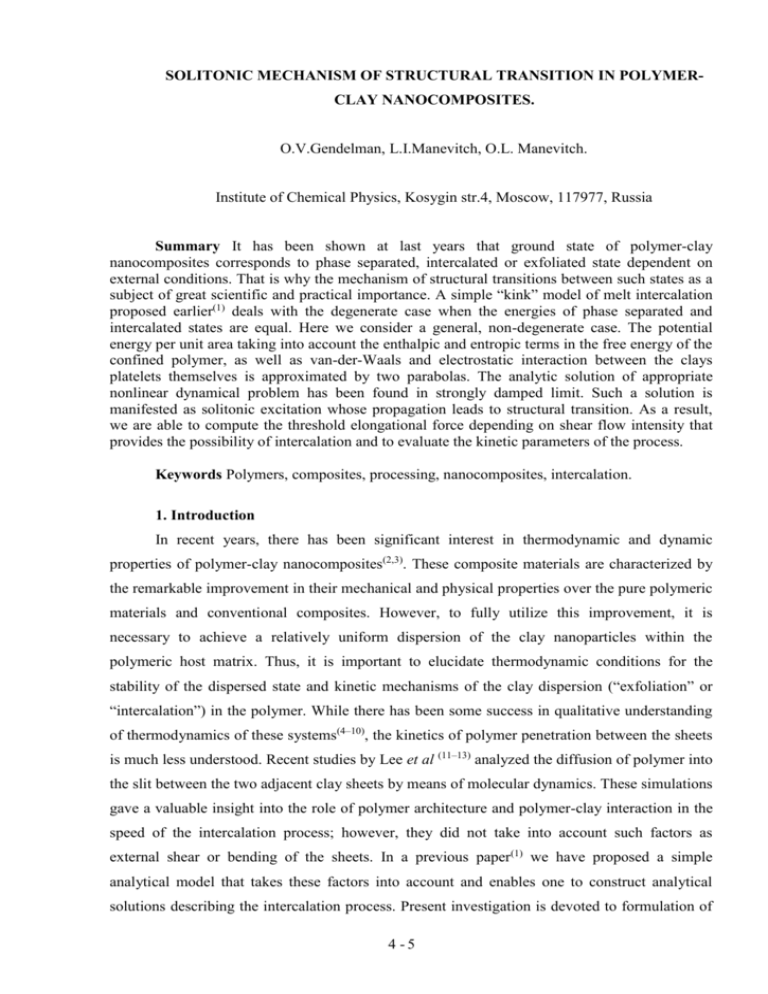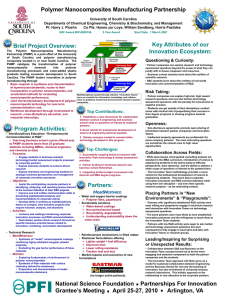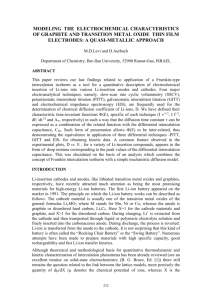Paper
advertisement

SOLITONIC MECHANISM OF STRUCTURAL TRANSITION IN POLYMERCLAY NANOCOMPOSITES. O.V.Gendelman, L.I.Manevitch, O.L. Manevitch. Institute of Chemical Physics, Kosygin str.4, Moscow, 117977, Russia Summary It has been shown at last years that ground state of polymer-clay nanocomposites corresponds to phase separated, intercalated or exfoliated state dependent on external conditions. That is why the mechanism of structural transitions between such states as a subject of great scientific and practical importance. A simple “kink” model of melt intercalation proposed earlier(1) deals with the degenerate case when the energies of phase separated and intercalated states are equal. Here we consider a general, non-degenerate case. The potential energy per unit area taking into account the enthalpic and entropic terms in the free energy of the confined polymer, as well as van-der-Waals and electrostatic interaction between the clays platelets themselves is approximated by two parabolas. The analytic solution of appropriate nonlinear dynamical problem has been found in strongly damped limit. Such a solution is manifested as solitonic excitation whose propagation leads to structural transition. As a result, we are able to compute the threshold elongational force depending on shear flow intensity that provides the possibility of intercalation and to evaluate the kinetic parameters of the process. Keywords Polymers, composites, processing, nanocomposites, intercalation. 1. Introduction In recent years, there has been significant interest in thermodynamic and dynamic properties of polymer-clay nanocomposites(2,3). These composite materials are characterized by the remarkable improvement in their mechanical and physical properties over the pure polymeric materials and conventional composites. However, to fully utilize this improvement, it is necessary to achieve a relatively uniform dispersion of the clay nanoparticles within the polymeric host matrix. Thus, it is important to elucidate thermodynamic conditions for the stability of the dispersed state and kinetic mechanisms of the clay dispersion (“exfoliation” or “intercalation”) in the polymer. While there has been some success in qualitative understanding of thermodynamics of these systems(4–10), the kinetics of polymer penetration between the sheets is much less understood. Recent studies by Lee et al (11–13) analyzed the diffusion of polymer into the slit between the two adjacent clay sheets by means of molecular dynamics. These simulations gave a valuable insight into the role of polymer architecture and polymer-clay interaction in the speed of the intercalation process; however, they did not take into account such factors as external shear or bending of the sheets. In a previous paper(1) we have proposed a simple analytical model that takes these factors into account and enables one to construct analytical solutions describing the intercalation process. Present investigation is devoted to formulation of 4 -5 more realistic model of the process, taking into account the initiation stage (initial opening of the galleries due to boundary effects) as well as kinetic peculiarities of the process arising from the non-degeneracy of the interaction between the polymer melt and clay platelets. 2. Description of the model Let us consider a system of two adjacent clay platelets [Fig. 1]. In the absence of polymer, they are in the aggregated (Ag.) state, and the distance between them is 0. When mixed with a polymer, the platelets can separate and form a narrow “gallery” of width U = U 0 which is filled by polymer chains. It is possible to calculate the potential energy per unit area V(U) [Fig. 2]; such a potential takes into account the enthalpic and entropic terms in the free energy of the confined polymers, as well as van-der-Waals and electrostatic interaction between the clay platelets themselves (see Refs.(4,5,8,9) for more details). We restrict ourselves to the cases where this potential has a double-well shape; that is, V(U) has a minimum at some point U0 > 0 in addition to the minimum at U = 0. (Such a situation was predicted theoretically(7,10), and observed experimentally(14) for the case when the polymeric host had a small volume fraction of “telechelic” chains with two ends strongly attracted to the clay or mica surfaces.) Then, the transition between the aggregated (Ag.) state (U = 0) and the intercalated (Int.) state (U = U0) can be described as a “switching” process in a bistable potential. Figure.1 Sketch of the polymer-clay system. Here, Ag. denotes the agglomerated (immiscible) state, and Int. denotes the intercalated state; U0 is the plate separation in this state. T is the external longitudinal force applied to the upper plate. Let us derive equations of motion for the plate separation U assuming, for simplicity, that the potential may be approximated by two parabolas [Fig.2]. The reasoning for such choice of potential is that the experiments and theoretical predictions allow to establish the positions of the minima of V(U), curvatures of the potential curves in the minima and the values of the energy per unit area in the minima. The exact shape of the potential function remains unknown (moreover, it is clear that in the intermediate region the description of the system via single variable U is rather doubtful). Therefore the model expression for the potential function has to take into account the information mentioned above and all other details may be chosen arbitrarily. The approximation of two parabolas satisfies this criterion and is convenient for the calculations. 4 -6 Figure 2. Sketch of the plate-plate interaction potential V(U). The values of the potential function and the displacement variable U are presented in dimensionless form introduced below. If we consider only the one-dimensional case U=U(x,t), the equations of motion have the following form (see, e.g., Landau and Lifshitz(15)): U 4U 2U V (U ) EJ 4 T 2 0 t x x U (1) where d is the thickness of a clay sheet, E is the Young modulus of the clay, I =d3/12 is the moment of inertia of a unit length of a clay sheet, is the “friction coefficient” (proportional to the bulk viscosity of the polymer melt), and T is the effective external force felt by the upper sheet [see Fig. 1(a)]. On average, one can estimate the magnitude of T as T ~ 2td, where t is the effective shear stress. Positive values of T correspond to the compression; negative values of T describe elongation. We neglect the inertial forces which are small in comparison with the viscous force; however, adding them would not qualitatively change our results. To obtain an exact analytical solution of Eq. (1), we adopt a piecewise parabolic form for the potential V(U)(16) (for the sake of simplicity the curvatures of both potential wells are adopted to be equal): 1 2 2 2 U , U U 0 / 4 V (U ) 2 2 U 0 1 2 (U U ) 2 ,U U / 4 0 0 4 2 (2) After introducing dimensionless variables u= U/U0, X= x(2/EI)1/4, =2t/, K=T/((EI)1/2), Eq. (1) can be rewritten as u 4u 2u f (u ) K 0 X 4 X 2 u (3) 4 -7 where 1 2 2 u , u 1 / 4 f (u ) 1 1 (u 1) 2 , u 1 / 4 4 2 (4) In order to solve the equation (3) appropriate boundary conditions must be specified. In earlier paper(1) the boundary conditions were formulated as vanishing of all the derivatives of u at X=, whereas u(+)=0, u(-)=1. Such a choice of the initial conditions corresponds to propagation of the kink and is justified well after the beginning of the process of the intercalation. However in the very beginning of the process the kink is not yet formed and the process should start from the edge of the platelet. The formation of the kink in the latter conditions corresponds to the beginning of the process of the intercalation and should be investigated separately. 3. Initiation of the process of the intercalation In order to describe the process of the initialization of the kink Equation (1) should be solved for stationary case (the term wit time derivative should be omitted) with boundary conditions corresponding to free edge at x=0 and all derivatives vanishing at x=+. At x=0 the appropriate conditions may be written as follows: U xx 0, TU x EJU xxx 0 (5) Besides, the case under consideration corresponds to small values of U, therefore only the left parabola should be taken into account. After introducing the dimensionless variables introduced above the problem may be presented in the following form: 4u 2u K u 0, 0 X X 4 X 2 X 0 : u XX 0, Ku X u XXX 0 X : u 0, (6) u 0 n 0 X n n The boundary condition at infinity allow to write down the nontrivial solution of (6) in the following form: u ( X ) C exp( x) cos( x ), X 0 (7) where C and are the constants necessary to satisfy the initial conditions, and are defined as Re( ), Im( ), 2 K K2 4 2 Substitution of (7) to boundary conditions (6) leads to the following equations: 4 -8 (8) (2 2 ) cos 2 sin 0 ( K 3 3 2 ) cos ( K 3 32 ) sin 0 (9) It is easy to demonstrate that the system (8)-(9) is consistent only for K*=1. This result means that for lower external stress the nontrivial profile is not formed and u=0 for all X; for K>1 the stationary profile cannot be sustained and the system becomes unstable. This fact allows to identify the computed value K* as limit loading corresponding to the initiation of the intercalation process. Returning to the physical values of parameters, we get the following evaluation of the critical stress: T * EI (10) 4. Kinetics of intercalation – propagation of the kink As it was mentioned below, the problem of the kink propagation may be formulated as the problem of stationary wave with derivatives vanishing at infinity, which satisfies Eqs. (3) and (4). Accordingly, the solution is searched in the form of stationary wave u=u(X-Vτ), where V is the velocity of the wave; therefore the problem is reduced to solution of two ordinary differential equations; these equations correspond to two intervals of u, where the potential function is parabolic. Both equations are therefore linear and their solutions should be matched at the point u=1/4. The matching conditions involve continuity of the solution u and three its derivatives. Namely, two following equations should be solved (z=X-Vτ): u1 4u1 2u 4 K 21 u1 0 z z z 0 u1 1 / 4 V (11) n u1 0 n 0, z z n u2 1 v v 4 v 2v 4 K 2 v 0 z z z 0 v 3/ 4 V (12) nv 0 n 0, z z n The solutions of these equations may be written as u1 exp( z )( A1 cos(1 z ) A2 sin( 1 z )), z z0 u2 1 exp(z )( B1 cos( 2 z ) B2 sin( 2 z )), z z0 (13) where z0 is yet unknown point of matching, ς and ξi, i=1,2, are defined in the following way: 4 -9 i Re( i ) , i Im( i ) i4 K i2 (1)i 1V i 1 0 (14) i 1,2 It is easy to prove that ς1 = ς2 = ς. The equations for matching allowing to determine the unknown parameters of (13) may be written in the following form: u1 ( z0 ) u 2 ( z0 ) 1 / 4 n (u1 u 2 ) z z0 0, n 1,2,3 z n (15) System (15) contains 5 equations for 5 variables – Ai, Bi, i=1,2 and z0. However this system has one crucial property – the value of z0 cannot be determined, as the initial equations (3) – (4) are autonomous and the solution cannot depend on any fixed point of matching z 0. Therefore the system is overdetermined, providing 5 conditions for 4 variables. Numerical solution with account of (14) demonstrates that all these conditions may be satisfied for only one certain nonzero value of the kink velocity. Namely, for K=1 the calculation gives V=0.5895. The corresponding plot of the solution is presented at Fig. 3. Fig.3. Shape of the kink of intercalation 5. Conclusions The above investigation allows establishing two new features of the model of intercalation of the polymer melt into the gallery formed by adjacent clay platelets: 4 -10 a) The process can be initiated if the external pressure (related to the external shear stress) approaches critical value T*. b) Further kinetics of the process is governed by the motion of the dynamical kinks with certain single velocity, i.e. further process does not need activation, at least in the idealized model presented here. The authors are grateful to RFBR (grant 01-03-33122), Commission for the Support of Young Scientists (6th Competition, grant No. 123) and to the Fund for Support of Young Scientists for the financial support. References [1] V.V.Ginzburg, O.V.Gendelman and L.I.Manevitch, Phys. Rev. Lett., 2001 86, 5073 [2] P. C. LeBaron, Z. Wang, and T. J. Pinnavaia, Appl. Clay Sci. 1999 15, 11 , and references therein. [3] E. P. Giannelis, R. Krishnamoorti, and E. Manias, Adv. Polym. Sci. 1999 138, 107 , and references therein. [4] R. A. Vaia and E. P. Giannelis, Macromolecules, 1997 30 7990 . [5] A. C. Balazs, C. Singh, and E. Zhulina, Macromolecules 1998 31, 8370 [6] Y. Lyatskaya and A. C. Balazs, Macromolecules 1998 31, 6676 . [7] E. Zhulina, C. Singh, and A. C. Balazs, Langmuir 1999 15, 3935. [8] V.V. Ginzburg, C. Singh, and A. C. Balazs, Macromolecules 2000 33, 1089. [9] A. C. Balazs, V.V. Ginzburg, Y. Lyatskaya, C. Singh, and E. Zhulina, in Polymer-Clay Nanocomposites, edited by T. Pinnavaia and G. Beall (Wiley, New York, 2000). [10] D.V. Kuznetsov and A. C. Balazs, J. Chem. Phys. 2000 112, 4365; 2000 113, 2479. [11] J.Y. Lee, A. R. C. Baljon, D.Y. Sogah, and R. F. Loring, J. Chem. Phys . 2000 112, 9112 . [12] A. R. C. Baljon, J.Y. Lee, and R. F. Loring, J. Chem. Phys. 1999 111, 9068. [13] J.Y. Lee, A. R. C. Baljon, and R. F. Loring, J. Chem. Phys. 1999 111, 9754. [14] E. Eiser, J. Klein, T. A. Witten, and L. J. Fetters, Phys. Rev. Lett. 1999 82, 5076. [15] L. D. Landau and E. M. Lifshitz, Theory of Elasticity (Pergamon, Oxford, 1986), Chap. 2, 3rd ed. [16] We use a piecewise quadratic potential only to simplify calculations and obtain exact analytical solutions. It is possible to obtain similar kink solutions numerically using φ4 or other double-well nonlinear potentials. 4 -11








